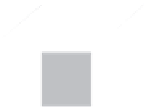Graphics Reference
In-Depth Information
C
(0)
in
C
in
C
(
i
),
α
i
C
,
α
C
out
C
(
N
)
out
Viewpoint
(a)
(b)
Figure 3.1
Overview of volume rendering with voxels. (a) Light is attenuated by each voxel accord-
ing to its opacity α. (b) The effect is cumulative through a sequence of voxels.
Given the formulas for light-voxel interaction, the problem remains of how
to render the volume into a final image. There are two basic approaches. One
is to project all the voxels onto an image plane and draw each projected voxel
into a framebuffer (
Figure 3.1
)
. This is aided by the depth component of the
framebuffer available in modern graphics hardware. Along with the RGB color
and the depth information, hardware depth buffers an
channel and can perform
the computation of Equation (3.1). Voxels do, however, have to be rendered from
“back to front”, so that the voxel closest to the viewpoint is rendered last.
The second approach is to trace rays through the volume. This is normally
done by tracing each ray from the viewpoint through the voxel grid (
Figure 3.2
)
.
The voxels are traversed in “front to back” order in this method; the recursive
formula of Equation (3.2) is applied to compute the final color.
Tracing rays through the voxels can result in a much better sampling of the
voxel than the image-plane projection approach. The typical technique, which is
α
Resampling
Ray
Viewpoint
Image plane
Figure 3.2
The ray-casting technique for volume rendering. Opacity can be sampled at many points
in each voxel.




















































































